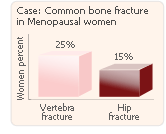
Osteoporosis can lead to crippling pain, permanent disability and even death. Osteoporosis is a major health problem which affects millions of people. Osteoporosis has an outsized impact on postmenopausal women. Half of all women who have reached the post menopause stage have developed a fracture caused by osteoporosis at some point during their lives. Twenty five percent of these women will have developed a fracture on their vertebra, while fifteen percent will suffer hip fracture, both painful and debilitating injuries. While one suffers from osteoporosis more with age, osteoporosis is also related to sex differences. Older men do not suffer from osteoporosis-related fractures at the same rate that women do. This is due to the dip in estrogen that occurs during menopause. The 2002 study: “Osteoporosis and Fractures in Postmenopausal Women Using Estrogen” explores how estrogen replacement therapies cut down on the suffering of osteoporosis in post-menopausal women.
A meta-analysis that combines the results of several two-year estrogen replacement studies shows that bone density increased seven percent in the spine, four in the neck and four point five percent in the forearm. Large studies have also shown a 20-35% percent reduction in hip fractures associated with to estrogen use, as well as reductions in fractures in a number of other places. These studies show that estrogen users receive some protection from osteoporosis and its related fractures. However, the authors of this study still wonder to what extent these estrogen users remain at risk for osteoporosis. The study also wonders what effect these estrogen supplements will have on women later in life when they are most at risk for osteoporosis.

The study recruited women over the age of sixty-five from communities across the country between the years of 1986 and 1988. Almost a thousand White and African-American women were studied, although those who had already had undergone a hip fracture were excluded. Although women currently using estrogen lost less bone density than those who had never taken estrogen or who had stopped taking it, all groups lost bone density from the hip and calcaneus area.
This study gives us the thought-provoking conclusion that although estrogen replacement therapy can help with osteoporosis, it is not a cure for all. Although it lessens bone loss, eighty percent of the women in the study experienced bone loss while receiving estrogen therapy. While the effects of estrogen therapy can continue for 10 or more years in the early menopausal period, it only guards against osteoporosis for two to three years in older women. However, estrogen did have the affect of combating against osteoporosis by increasing the mechanical strength of the proximal femur. It is recommended that the nature of bone loss of women taking estrogen be studied.